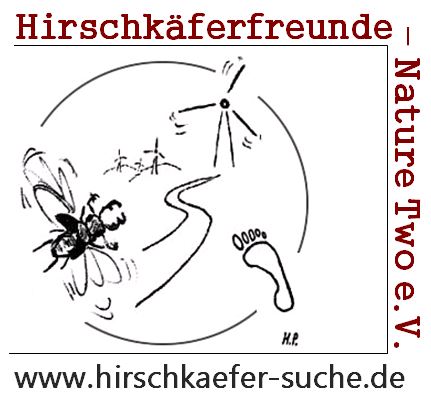Stag beetle search
Stag beetles (“Hirschkäfer” in German) are found in very diverse habitats. Not seldom in the vicinity of humans. Nevertheless, many of us do not know them and only a few have ever seen this quite imposing beetle species themselves. This was different in former times, historical names such as Feuerschröter, Donnergugi, Pferdeklemmer or Fliegender Hirsch (all german names) even refer to its mythical importance for humans in history.
With these sites we would like to bring a traditional beetle closer to you again, to promote it and at the same time, with your help, to collect important data about habitat use and way of life of this useful species.
Furthermore we turn more and more to the practical protection of this species. But we will also face new challenges. The issue of insect decline has reached the heart of society. At the moment, it seems that the stag beetle is not so much affected. Nevertheless, we take up this important topic and will get involved, currently with the planting of flower meadows as well as information on this website.
Our investigations in Germany so far indicate a larger distribution than originally assumed. Continuous changes in the landscape and, according to our own investigations, also climate change will pose new challenges to the largest Central European beetle. Current issues such as densification in villages and cities or wind power in forests often affect its nesting habitats. Landscape destruction continues, and even worse, it is being facilitated.
The British scientist Dr. Deborah Harvey began her research on the stag beetle in Great Britain 22 years ago at the same time as I did. With her, and in the meantime a whole series of European scientists, we maintained a constructive collaboration over many years. The transnational exchange of survey data on the occurrence of the stag beetle and a parallel evaluation analysis of possible climatic and landscape influences may enable us to make more specific statements on a future stag beetle population and the associated habitat forecast. For this purpose, a transect procedure for effective monitoring was also developed with our cooperation. Decisive preliminary work for this was done at the 3rd European Stag-Beetle-Meeting in 2013 in Alf an der Mosel. Already in 2011 we founded the non-profit association Hirschkäferfreunde-Nature two. e.V., which currently has 100 members. The association supports the search and its members not only act as supporters, but are multipliers and also lead projects on site. In 2019, we were chosen by citizen vote as a UN Decade Project and a year later, an expert jury even chose us as Project of the Year 2020.
The stag beetle was Insect of the Year 2012 in Germany, Switzerland and Austria, on this occasion we had already significantly expanded our information offering and continue to do so. In 2022, we will again ensure improvements and, in addition to the “search”, we will focus on the area of “stag beetle protection in practice”. Locally, but also supra-regionally, we initiate projects such as in the BioKlimaWald in Alf or the stag beetle monitoring in the Dürrfelder Forest in Langenlonsheim on the Nahe.
We are already in our 7th year of collecting data for the Bavarian State Institute for Forests and Forestry (“Wald und Forstwirtschaft”, or LWF in short), and a few years ago we added the survey for the province of Voralberg in Austria (inatura). We and others use synergy effects.
Result 1:
The stag beetle (Lucanus cervus) lives tree-related, it does not know terms like forest, open land, city or village, but is oriented to the conditions in and around the tree(stump).
Result 2:
The stag beetle is a successful cultural successor in Germany, whether it will remain so is questionable.
Result 3:
The number of annual reports has been increasing since the start in 2011. New habitats are still being added. Record: 2020: over 4000 reports.
Result 4:
The stag beetle is endangered because its cultural successor property is persistently ignored in nature conservation. Real nature conservation falls behind in the current climate protection efforts. Lucanus cervus will also feel the effects of this.
German Environment Minister Svenja Schulze recognizes UN Decade Year Project 2020 (German)

